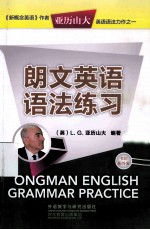

朗文英语语法练习PDF电子书下载
- 电子书积分:15 积分如何计算积分?
- 作 者:(英)L.G.亚历山大编著
- 出 版 社:北京:外语教学与研究出版社
- 出版年份:2013
- ISBN:9787513533409
- 页数:471 页
1句子The sentence 1
1.1句子的词序(sentence word order) 1
1.2简单句(simple sentence):带和不带宾语的动词 3
1.3简单句:直接和间接宾语(direct and indirect objects) 6
1.4并列句(compound sentence) 9
1.5复合句(complex sentence):名词从句(noun clause) 12
1.6复合句:关系代词及关系从句(relative pronoun and clause) 15
1.7复合句:whose;限定性/非限定性从句(defining/non-defining clause) 18
1.8复合句:时间、地点、方式 21
1.9复合句:原因和对比 24
1.10复合句:目的、结果和比较 27
1.11复合句:现在分词结构(present participle construction) 29
1.12复合句:完成时/过去分词结构(perfect/past participle construction) 32
2名词Nouns 35
2.1单一名词(one-word noun) 35
2.2复合名词(compound noun) 38
2.3可数名词和不可数名词(countable and uncountable nouns) (1) 42
2.4可数名词和不可数名词(2) 45
2.5数(number)(单数与复数)(1) 48
2.6数(单数与复数)(2) 51
2.7性(gender) 54
2.8所有格(genitive) 57
3冠词Articles 61
3.1不定冠词(indeflnite article) : ‘a/an’ (1) 61
3.2不定冠词:‘a/an’(2) 63
3.3定冠词(definite article):‘the’(1) 66
3.4定冠词:‘the’(2) 69
3.5零冠词(zero article)(1) 73
3.6零冠词(2) 76
4代词Pronouns 80
4.1人称代词(personal pronoun) 80
4.2 One 83
4.3 it和one/some/any/none 86
4.4所有格形容词和所有格代词(possessive adjective and possessive pronoun) (‘my/mine’) 89
4.5反身代词(reflexive pronoun) (‘myself’) 92
4.6指示形容词/代词(demonstrative adjective/pronoun) (‘this’等) 95
5数量 Quantity 98
5.1数量词(quantifier)+可数和不可数名词 98
5.2泛指和特指数量 101
5.3 some, any, no和none的用法 104
5.4 much, many, a lot of, (a) few, (a) little, fewer, less 107
5.5 both和all 110
5.6 all(the),(a/the) whole,each和every 113
5.7 another, (the) other(s),either,neither,each (one of) 116
6形容词Adjectives 119
6.1形容词的构成 119
6.2形容词的位置 121
6.3名词性形容词;以-ed/-ing结尾的作形容词用的分词 124
6.4在be, seem等后的形容词;形容词的词序 127
6.5形容词的比较级(comparison) 130
7副词Adverbs 134
7.1方式副词(adverb of manner) 134
7.2时间副词(adverb of time) 137
7.3表示持续时间的副词短语(adverbial phrase of duration) 140
7.4频度副词(adverb of frequency) 143
7.5程度副词(adverb of degree) 145
7.6强调成分(intensifier) 148
7.7焦点副词(focus adverb) 152
7.8观点副词、连接副词和倒装(viewpoint adverb, connecting adverb and inversion) 154
8介词、副词小品词和短语动词Prepositions, adverb particles and phrasal verbs 158
8.1介词、副词小品词和连词(conjunction) 158
8.2表示动作和位置的介词:表示时间的介词 161
8.3特殊的介词、小品词(particle):对比(1) 164
8.4特殊的介词、小品词:对比(2) 167
8.5特殊的介词、小品词:对比(3) 171
8.6短语动词(phrasal verb):第1类,动词+介词(及物) 174
8.7短语动词:第2类,动词+小品词(及物) 177
8.8短语动词:第3类,动词+小品词(不及物)第4类,动词+小品词+介词(及物) 180
9动词、动词时态、祈使语气Verbs, verb tenses, imperatives 184
9.1一般现在时和现在进行时(simple present and present progressive tenses)(1) 184
9.2一般现在时和现在进行时(2) 187
9.3一般过去时(simple past tense) 190
9.4一般过去时和过去进行时(past progressive tense) 193
9.5一般现在完成时和现在完成进行时(simple present perfect and present perfect progressive tenses) 196
9.6一般过去完成时和过去完成进行时(simple past perfect and past perfect progressive tenses) 199
9.7一般将来时(simple future tense) 203
9.8一般将来时、将来进行时(future progressive tense)、将来完成时(future perfect tense) 206
9.9用going to和其他形式表示将来 209
9.10祈使语气(imperative) 212
10动词Be,Have,Do 215
10.1完全动词(full verb) be(1) 215
10.2完全动词be(2) 218
10.3There + be 221
10.4在意义上与be相近的动词 224
10.5 have作为完全动词=“具有”;have got=“具有” 227
10.6 have作为完全动词表示“吃”、“享受”等 230
10.7完全动词do 232
11情态助动词和有关动词Modal auxiliaries and related verbs 236
11.1情态动词(modal verb)的两种用法 236
11.2情态动词等表示能力或无能力的用法 239
11.3表示允许和禁止的情态动词等的用法 242
11.4表示肯定和可能的情态动词的用法 245
11.5表示推论的情态动词的用法 247
11.6表示提供、请求和建议的情态动词的用法 250
11.7用I wish,if only,it’s (high) time表示愿望等 253
11.8用would rather和would sooner表示宁愿 256
11.9宜于…/必须 259
11.10不宜…/不必要…/禁止 262
11.11表示习惯的情态动词:used to,will和would 265
11.12 need和dare作为情态动词和完全动词 268
11.13 would/wouldn’t; that…should; there+情态动词 271
12被动语态和使役式The passive and the causative 274
12.1被动语态概说 274
12.2被动语态的用法 276
12.3使役式的形式和用法 279
13疑问句、答语、否定句 Questions, answers, negatives 283
13.1一般疑问句(Yes/No question),否定陈述句(negative statement),简略答语(Yes/No answer) 283
13.2其它否定形式和否定疑问句(negative question) 286
13.3附加疑问句(tag question)和反问附加疑问句(echo tag) 289
13.4补充句(addition)及反应句(response) 292
13.5疑问词疑问句(question-word question) (1) :‘Who(m)…?’‘ What…?’ 295
13.6疑问词疑问句(2) : ‘When?’,‘Where?’, ‘Which?’, ‘Whose?’ 298
13.7疑问词疑问句(3) : ‘Why?’,‘How?’ 301
13.8主语疑问句(3) : ‘Who?’,‘What?’ , ‘Which?’, ‘Whose?’ 304
13.9选择疑问句(question about alternatives);带有ever的强调疑问句(emphatic question) 306
14条件句Conditional sentences 310
14.1第1类条件句 310
14.2第2类条件句 313
14.3第3类条件句 316
14.4混合条件句:‘unless/if…not’等 319
15直接引语和接引语Direct and indirect speech 322
15.1直接引语(direct speech) 322
15.2 say,tell和ask 325
15.3改变时态的间接陈述句(indirect statement) 328
15.4间接疑问句(indirect question)的时态变化 330
15.5间接引语中带to的不定式(to-infinitive)用法 333
15.6何时使用间接引语 336
16不定式和“-ing”形式The infinitive and the ‘-ing’ form 339
16.1不带to的不定式和带to的不定式 339
16.2用不带to的不定式还是用“-ing”形式;带to的不定式 342
16.3动词(+名词/代词)+带to的不定式 345
16.4形容词和名词+带to的不定式 348
16.5 “-ing”形式 351
16.6动词+“-ing”形式 354
16.7形容词、名词和介词+“-ing”形式 358
16.8带to的不定式还是“-ing”形式? 361
索引 364
答案 382
- 《培生高级英语语法 练习册》培生教育 2019
- 《小提琴经典练习曲简编 沃尔法特》丁芷诺,杨宝智 2019
- 《马扎斯小提琴华丽练习曲27首 Op.36 第2册》梁·著 2018
- 《竹笛四重奏练习三十三首 简谱版》郝益军编著 2018
- 《竹笛三重奏练习三十一首 简谱版》郝益军编著 2018
- 《杜弗诺伊 钢琴练习曲15首(大音符版) 作品120》方百里编注 2019
- 《HSK标准教程 4 上 练习册》姜丽萍主编 2015
- 《沃尔法特小提琴练习曲60首 Op.45 练习提示》梁訢编著 2018
- 《计算机自适应英语语用能力测试系统设计与效度验证 以TEM4词汇与语法题为例》张一鑫著 2019
- 《什密特钢琴五指练习曲 作品16》申浩 2019
- 《市政工程基础》杨岚编著 2009
- 《家畜百宝 猪、牛、羊、鸡的综合利用》山西省商业厅组织技术处编著 1959
- 《《道德经》200句》崇贤书院编著 2018
- 《高级英语阅读与听说教程》刘秀梅编著 2019
- 《计算机网络与通信基础》谢雨飞,田启川编著 2019
- 《看图自学吉他弹唱教程》陈飞编著 2019
- 《法语词汇认知联想记忆法》刘莲编著 2020
- 《培智学校义务教育实验教科书教师教学用书 生活适应 二年级 上》人民教育出版社,课程教材研究所,特殊教育课程教材研究中心编著 2019
- 《国家社科基金项目申报规范 技巧与案例 第3版 2020》文传浩,夏宇编著 2019
- 《流体力学》张扬军,彭杰,诸葛伟林编著 2019
